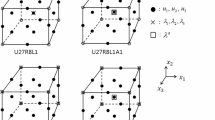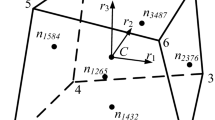Abstract
The new methods to determine the zero-energy deformation modes in the hybrid elements and the zero-energy stress modes in their assumed stress fields are presented by the natural deformation modes of the elements. And the formula of the additional element deformation rigidity due to additional mode into the assumed stress field is derived. Based on, it is concluded in theory that the zero-energy stress mode cannot suppress the zero-energy deformation modes but increase the extra rigidity to the nonzero-energy deformation modes of the element instead. So they should not be employed to assume the stress field. In addition, the parasitic stress modes will produce the spurious parasitic energy and result the element behaving over rigidity. Thus, they should not be used into the assumed stress field even though they can suppress the zero-energy deformation modes of the element. The numerical examples show the performance of the elements including the zero-energy stress modes or the parasitic stress modes.
Similar content being viewed by others
References
Pian T H H. Derivation of element stiffness matrices[J]. AIAA, 1964, 2(3):576–577.
Huang Qian. Modal analysis of deformable bodies with finite degree of deformation freedom-an approach to determination of natural stress modes in hybrid finite elements[C]. In: Chien Weizang, Fu Zi-zhi(eds). Advances in Applied Mathematics & Mechanics in China. IAP (International Academic Publishers), Beijing, 1991, 3:283–303.
Han J, Hoa S V. A three-dimensional multilayer composite finite element for stress analysis of composite laminates[J]. International Journal for Numerical Methods in Engineering, 1993, 36(22):3903–3914.
Feng W, Hoa S V, Huang Q. Classification of stress modes in assumed stress field of hybrid finite elements[J]. International Journal for Numerical Methods in Engineering, 1997, 40(23):4313–4339.
Wu Changchun, Pian T H H. Incompatible Numerical Analysis and Hybrid Finite Element Method[M]. Science Press, Beijing, 1997, 129–174 (in Chinese).
Pian T H H, Chen D P. On the suppression of zero energy deformation modes[J]. International Journal for Numerical Methods in Engineering, 1983, 19(12):1741–1752.
Cheung Y K, Wu C C. A study on the stability of 3-fild finite elements by theory of zero energy modes[J]. International Journal for Solids & Structures, 1992, 29(2):215–229.
Zhang Canhui, Feng Wei, Huang Qian. A characteristic study of natural stress modes and stress subspace in hybrid finite element method[J]. Chinese Quarterly of Mechanics, 2002, 23(1):9–14.
Zhang Canhui, Feng Wei, Huang Qian. The stress subspace of hybrid stress element and the diagonalization method for flexibility matrix H[J]. Applied Mathematics and Mechanics (English Edition), 2002, 23(11):1263–1273.
Author information
Authors and Affiliations
Corresponding author
Additional information
Contributed by HUANG Qian
Rights and permissions
About this article
Cite this article
Zhang, Ch., Huang, Q. & Feng, W. Deformation rigidity of assumed stress modes in hybrid elements. Appl Math Mech 27, 861–869 (2006). https://doi.org/10.1007/s10483-006-0701-z
Received:
Revised:
Issue Date:
DOI: https://doi.org/10.1007/s10483-006-0701-z
Key words
- hybrid stress element
- element deformation rigidity
- zero-energy stress mode
- zero-energy deformation mode




